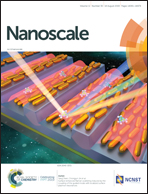Surface-enhanced Raman scattering induced by the coupling of the guided mode with localized surface plasmon resonances†
Abstract
Surface-enhanced Raman spectroscopy (SERS) is considered to be a powerful analysis tool for the detection of molecules due to its ultra-high sensitivity and non-destructive nature. Here, we introduce a new type of hybrid SERS substrate, where gold nanorods are assembled on a structured support containing a top dielectric grating, dielectric spacer and gold mirror. Compared with the conventional metal nanoparticle assemblies on a flat support, our hybrid substrate shows an approximately 30-fold enhancement in the SERS signal. Numerical simulations show that such a substantial boost arises from the amplification of the absorption cross sections of the gold nanorods and the heating of the “hot spots” around the gold nanorods by the coupling between the guided mode in the structured support and the localized surface plasmon resonances. This mode coupling can be easily tuned by changing the thickness of the spacer. In addition, this substrate also presents uniform spot-to-spot and sample-to-sample SERS signals of the analyte molecules (relative standard deviations down to 7.4% and 6.1%, respectively). Moreover, the performance of this substrate has been demonstrated with the detection of melamine and cytosine, suggesting its great potential in food safety regulation and bioassays. This grating-mirror-enhanced strategy is available to any other SERS-active nanoparticles synthesized by chemical methods, which might offer new opportunities for improving the performance of the chemically prepared nanoparticles in realistic SERS-related applications.



 Please wait while we load your content...
Please wait while we load your content...